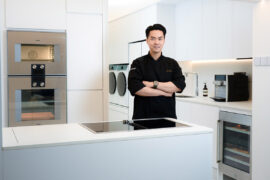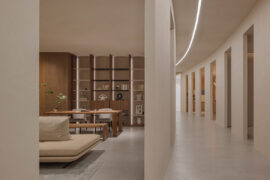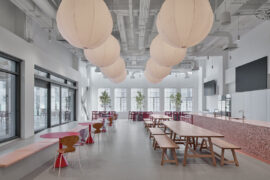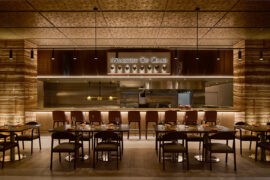The newly appointed principal at HASSELL believes that designers have a social responsibility to create sustainable, healthy places for the next generation.

“My key influencers are my children. When you have a family, you realise responsibility sits with you to create better environments, a more sustainable way of building places, and ultimately spaces where my children, and future generations, will thrive growing up,” says HASSELL’s newly appointed principal Natalie Busch.
As practice leader and now appointed principal, Natalie has been an influential part of the HASSELL Perth team for 14 years with experience combining urban design with architecture and landscape architecture to create healthy, sustainable, and exciting public realm spaces.

Karratha. Photo by Robert Frith.
“When I first started in the industry there was definitely a focus on how things looked, but there’s been a real shift to create places that affect how people feel within a space. There are some scary statistics around the increase in mental health issues, and as designers we have an opportunity to improve the everyday lives of people. It can be on the micro-scale from a house or an office, to the macro and how you design an entire city,” she adds.

St. Ives Carine. Photo by Dion Robeson
“One of the first projects I worked on was the Fiona Stanley Hospital in Perth, it was my introduction into the health sector design environment. That to me was a game-changer because through our work, we found out there was fundamental evidence that if you create places that allow interaction between people, access to natural light, air, and gardens, patients were happier, healthier, and less reliant on medication. If that can happen in such an acute environment, we should be applying that same thinking to everything that we do. It’s changed how I approach every single project,” says Busch.
Boasting a Bachelor of Architecture with first-class honours, Busch is also a registered landscape architect. She is the 2019 WA President of the National Association of Women in Construction (NAWIC) and sits on the WA State Design Review Panel. Recently, Busch has been involved in the award-winning Karratha Health Campus project, St Ives Carine residential aged care development in Perth’s northern suburbs, and the University of Western Australia’s new engineering hub, EZONE.

St Ives Carine. Photo by Dion Robeson
When asked about what projects excite her the most, Natalie says it is the clever in-between spaces. “It excites me to be able to draw something impactful out of a space that wasn’t there in the brief, like a wide stairwell that forces interaction, or benches that face each other to reduce isolation. They seem minor but they can make the biggest difference to student experiences, and ultimately their livelihoods.”

Karratha Health Campus. Photo by Robert Frith.
HASSELL principal Brenden Kelly says that Busch’s highly collaborative nature when working with clients and her multi-disciplinary skillset has always allowed her to develop rich relationships and trust.
“Natalie does a fantastic job at encouraging everyone involved in a project to keep the design process as collaborative as possible, this is a trait that HASSELL prides itself on instilling across the entire practice. We’re looking forward to seeing Natalie thrive in this new role,” says Kelly.
We think you’d like this story about Australian healthcare design.
INDESIGN is on instagram
Follow @indesignlive
A searchable and comprehensive guide for specifying leading products and their suppliers
Keep up to date with the latest and greatest from our industry BFF's!

Now cooking and entertaining from his minimalist home kitchen designed around Gaggenau’s refined performance, Chef Wu brings professional craft into a calm and well-composed setting.

Merging two hotel identities in one landmark development, Hotel Indigo and Holiday Inn Little Collins capture the spirit of Melbourne through Buchan’s narrative-driven design – elevated by GROHE’s signature craftsmanship.

At the Munarra Centre for Regional Excellence on Yorta Yorta Country in Victoria, ARM Architecture and Milliken use PrintWorks™ technology to translate First Nations narratives into a layered, community-led floorscape.

Designed by RADS, the space redefines the lobby not as a point of passage, but as a destination in itself: a lobby bar, a café, and a small urban hinge-point that shapes and enhances the daily rituals of those who move through it.

The Simple Living Passage marks the final project in the Simple World series by Jenchieh Hung + Kulthida Songkittipakdee of HAS design and research, transforming a retail walkway in Hefei into a reflective public space shaped by timber and movement.
The internet never sleeps! Here's the stuff you might have missed

The new headquarters for Omnicom in Melbourne’s CBD sees heritage re-invigorated with style and finesse.

After more than two decades at Architects EAT, Eid Goh launches AIR, a new Melbourne-based studio focused on adaptive reuse, hospitality and human-centred design across commercial and civic projects.